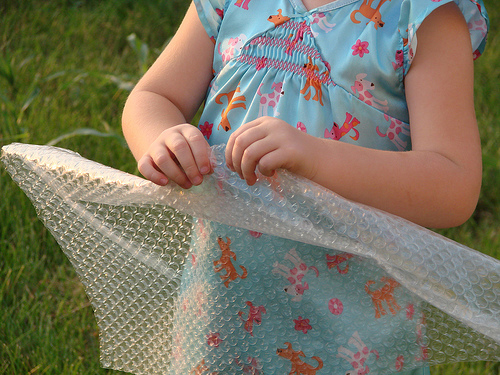Send your question to Umbra!
Q. Dear Umbra,
I just got married and received a lot of presents in the mail. I recycled/reused all the boxes, but I’m still stuck with a LOT of bubble wrap and sealed air. Is there a place where I can take these rolls of plastic to be recycled?
Johnny
Washington, D.C.
A. Dearest Johnny,
Congratulations and best wishes for a long and happy marriage. You may wish to retain a portion of the bubble wrap for use during periods of marital fragility.
I have several ideas on the recycling of said wrap, which boil down to this: Find a place to recycle it. Find a place that will reuse it. Or reuse it yourself.
 mollypop via flickrNormally, as you may know, I defer to your local recycling service for such questions. The D.C. recycle website is silent on the matter of bubbles and sealed air, though they adamantly refuse packing peanuts. They do accept a variety of plastics, including plastic bags, so you should call them and see if they accept deflated sealed air — which, after all, is a clean plastic film not unlike a plastic bag and is even made from the same material, polyethylene.
mollypop via flickrNormally, as you may know, I defer to your local recycling service for such questions. The D.C. recycle website is silent on the matter of bubbles and sealed air, though they adamantly refuse packing peanuts. They do accept a variety of plastics, including plastic bags, so you should call them and see if they accept deflated sealed air — which, after all, is a clean plastic film not unlike a plastic bag and is even made from the same material, polyethylene.
Most of us have made the egregious error of using “bubble wrap” to refer to all air cellular cushioning material. Only the trademarked (and presumably vastly superior) Bubble Wrap manufactured by the Sealed Air Corporation deserves the name. Or so the Sealed Air Corporation says. You see, air cellular cushioning material is made by heating and extruding polyethylene beads out of a tube until they form two layers of film. One layer of film is then wrapped around a holey drum. Air sucks the film into the drum, forming the future bubbles, and the second layer of film is laminated on top to seal the deal. The SA Corp uses a secret other layer of lamination to stop air leakage in the bubbles, rendering competitors’ products inferior. True Bubble Wrap might also make the most satisfying popping sound — I cannot say.
If you cannot find a local bubble wrap recycling business (use the internet and Earth 911), you can often ship bubbles and puffy sacks back to the manufacturer. You might also try your luck with shipping facilities like The UPS Store and its ilk, museums that might need bubble wrap to protect works of art, or sites such as Craigslist and Freecycle. One man’s dilemma is another’s treasure find.
One other thing you might consider is finding uses for the bubble wrap around your home. Put “recycle bubble wrap” into Google and you will find all manner of interesting suggestions, from the sensible (use it between walls and furniture for protection) to the downright silly (wrap your feet in it for winter warmth).
Poppingly,
Umbra


